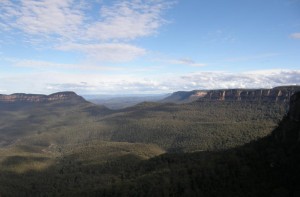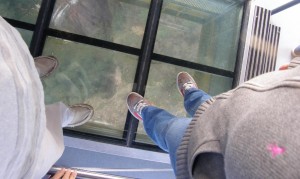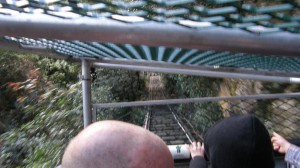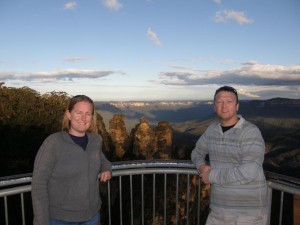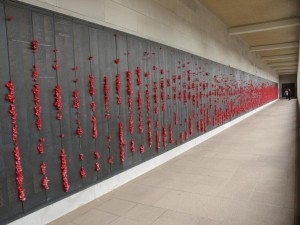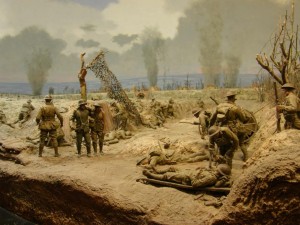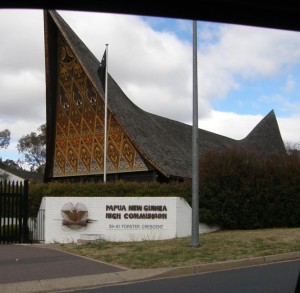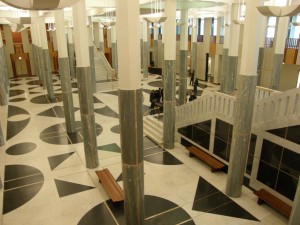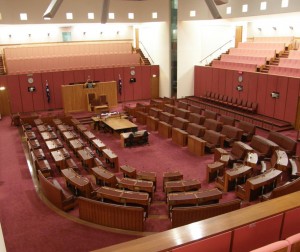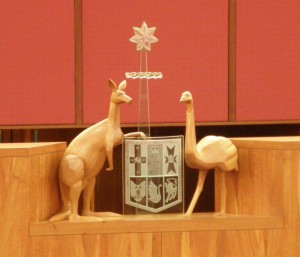I’m writing today’s blog while we drive, as I was planning to do it last night and completely forgot! Today is going to be a full day of driving, so I thought it would be a good chance to catch up, in between enjoying the scenery, flicking through songs on the iPod, and reading to Chris. We’ve just set off from the picnic area where we spent the night, a place called White Rock in the Coopracambra National Park – we were on our own there last night and had a lovely evening, watching the end of the first series of Game Of Thrones, and cooking a meal with as many of the leftover ingredients in our cupboard as possible! We’ve only got a couple of nights left to stay in the van, we realised yesterday – tonight we’re arriving in Melbourne where we’re going to stay with Rod and Barb, who we met on the boat in the Whitsundays a few weeks ago. Then it’s a couple of days’ drive to Adelaide, where we’re going to be staying with Karen, and then we drop the van off and catch our flight to Alice Springs.
We’ve loved our time in the campervans, here and in New Zealand – it’s really been fun learning to live in such a small space, and having our home with us everywhere we go! It’s so handy to arrive somewhere and realise there’s somewhere to swim, so we just jump back in the van, shut the curtains and change into our cossies – or be driving along and decide we’re hungry, so we pull over and cook a meal and sit looking at the view out of the windows as we eat – or deciding we’re had enough of driving for the day, and pulling over in the next picnic area, making our bed and going to sleep – it’s such a great way to travel! We are really looking forward to the last couple of weeks of our trip – Alice Springs, Darwin, then Singapore will each feel like a separate little holiday! But we will be sad to take back our campervan – it’s been lovely travelling in it!
Anyway – from Nambucca Heads, where we wrote the last blog post, we spent the whole of the next day driving south along the coast of New South Wales. Thankfully, as we drove, we moved out of the rain and into blue skies and sunshine – we were very relieved to be out of the rain! The weather makes such a difference to everything, and we had a much nicer day driving in the sunshine. We were heading towards the Blue Mountains, and had decided to aim towards them from the inland route to the North, via the Hunter Valley. We were aiming for a town called Denman (which must be where the wine comes from!) but actually, when we looked at the map we realised there was a shortcut onto the road we wanted, so we bypassed Denman. We ended up on a route called Putty Road, through the National Parks north of the Blue Mountains – an absolutely lovely drive, a big winding road through the forests that’s very popular with motorcyclists. We started looking for somewhere to stay at about 4pm, and drove for almost an hour without spotting anything better than lay-bys, so when we did finally find a spot off the road we stopped there gladly. It was 200m down the road from an abandoned-looking roadhouse, which still had working toilets with a sign saying ‘$1 per person’, and a field for camping. We didn’t want to pay for camping, but we went up and paid for the toilets, so we had a proper loo to use, at least! We made supper and went to bed, but were kept awake for a while by noises outside the van – we’re still not sure what it was, but obviously some sort of wildlife was attracted by our cooking smells!
The next morning, we drove down into the Blue Mountains via Kurrajong and Lithgow, to Katoomba, which is the main town in the Blue Mountains, near all the famous sights like the Three Sisters. I had a good map in one of the brochures I’d picked up from the NSW information centre, so we ignored the TomTom and navigated by map along all the roads that looked like they’d be the most scenic. We drove along an amazing road called Cliff Drive, between Katoomba and Leura, and stopped at a few lookout points – Katoomba is high up on a ridge, with an amazing view out over the valley, so the view from every lookout was stunning. We eventually stopped at Scenic World, which is a huge and rather touristy complex built on the edge of the cliffs, with a cable-car and a mountain railway down to the valley below where they’ve built miles of boardwalks through the forest, and a scenic cable-car (with a partially glass floor!) across to the other side of the cliffs, with a view out across the valley to the Three Sisters and Mount Solitary, and a view down the cliffs to Katoomba Falls. It was full of tour groups, and crowded and impersonal and all that, but we were still very glad we decided to brave the crowds – the views were absolutely amazing, and it was a great way to see everything.
We bought a ticket that covered a return ride on the scenic cable-car, then a trip into the valley on the railway and back up on the cable-car. The scenic cable-car was very cool, we stood on the glass-bottomed section for a while with wobbly knees, and enjoyed the views – we got out at the other side and walked down to the lookout point, before getting the next ride back. Chris’s camera had run out of batteries, so we went back into the main complex to buy batteries, and had a coffee while we were there, and marvelled at the number of things you can write ‘Blue Mountains’ on and sell as souvenirs (Blue Mountains Placenta Face Cream, anyone?) Then we wandered down to the railway, which was amazing – it’s the steepest mountain railway in the world at 52°, and you have to wedge yourself in with your knees against the seat in front of you – it feels more like a rollercoaster than a train! We were quite far back in the queue, and by the time we got to the platform we were being directed towards the last carriage, which had plastic sheeting over the roof, spoiling the view. I asked one of the guys if we could wait for the next train, and he pointed us down to the front where there were two spare seats in the second row! So we got an excellent view of the steep tracks all the way down, and the valley floor rushing up to meet us!
When we got to the bottom, we wandered off along the longest section of boardwalk, and within five minutes we were on our own – it’s amazing, no one wants to walk anywhere, there must have been 100 people who got off the railway with us and they must all have walked straight along the shortest section straight to the cable-car. We walked around a long loop for an hour or so, enjoying the peacefulness of the forest, and reading all the informational signs about different trees and features. We bumped into one or two other people during the whole hour! Eventually we made our way back to the cable-car for a crowded return journey back up the cliffs. We thoroughly enjoyed the whole thing, it was all very well done.
We still had an hour or so before dark, so we drove further along the cliff-top drive, and got out at Echo Point, which is the closest viewpoint to the Three Sisters. The light on the cliffs was beautiful, with the sun low in the sky, so we walked down to the lookout and took some photos, then carried on along the cliff road to Sublime Point, which is at the end of a point that juts out over the valley, with an amazing view from both sides of the narrow spit. We walked down the path to the very end, where it was incredibly windy – we stayed just long enough to see the sun set behind the mountains, stunning! Then scurried back to the car out of the wind, and drove back through the town to the caravan park we’d booked into for the night.
It was a cold, windy night and we were both chilly during the night, so in the morning we decided the first priority was to go and buy some extra warm bedding! We got up and had showers, and drove over to the camp kitchen, where we made bacon and eggs for breakfast on one of the gas BBQs – an interesting experiment, we hadn’t tried one of the free BBQs before, and they’re very handy. They’re basically a sloped steel surface, so just a hotplate, and you press a button for five minutes of gas at a time, and cook on it then clean it off for the next person. There must be a knack to cooking eggs on them, I couldn’t work it out at all, the eggs kept slipping down the slope of the surface! In the end we had bacon and half-fried, half-scrambled eggs, which were nonetheless very yummy! Then we headed into town to the big K-Mart, and bought two cheap sleeping bags which we can zip together into a double, and can also use for the Uluru trip, and also a big fleece blanket. So the last couple of nights we’ve been toasty, in our double sleeping bag with the duvet and the fleece blanket over the top, all tucked in around the edges of the mattress!
Once we’d done our shopping, we started our drive down toward Canberra, along the rest of the Blue Mountains highway. It was only a couple of hours’ drive, and very scenic – huge wide plains, and it was lovely and sunny, so we enjoyed the drive. We’d been reading through the Canberra brochures and sections of the guidebook, and decided the places where we wanted to go, so when we arrived at about 3 p.m. we went straight to the first place we wanted to visit, the National War Memorial. It’s an absolutely amazing place – beautiful building, and the main section of it is a memorial with an eternal flame burning in a pool, and the Tomb of the Unknown Australian Soldier in a beautiful hall with stained glass windows and mosaics. Along the sides of the memorial there are plaques with the names of all the Australians killed in all the conflicts since WW1 – thousands and thousands of names. In the cracks between all the plaques, people leave poppies, either against a particular name or just in general. There’s a new plaque at one end with names of soldiers killed in Iraq and Afghanistan, with hundreds of poppies packed around them.
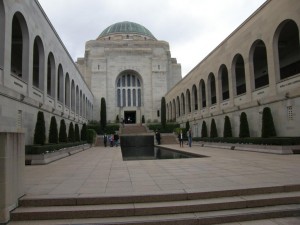
The War Memorial, looking past the Eternal Flame and into the Tomb of the Unknown Australian Soldier
Once we’d had a look around the memorial, we went downstairs into the exhibition halls, where there’s an excellent museum with big displays on WW1 and WW2, with lots of artifacts, uniforms, weapons, and amazing dioramas of different scenes, with written captions explaining everything in them. The 3D dioramas are somehow much more evocative than a painting or a photo – it’s a great way to show what was happening. There was also a display on all the Australians who’ve been awarded the George Cross, with photos and little captions telling their stories. There was a display on aircraft, which Chris enjoyed, but the one I spent the most time in was a display about prisoner of war camps in Japan, Singapore, Timor, and the other Far Eastern countries – just horrific photos and stories and recordings of people talking about their memories of the camps. There was a quilt made by women in a POW camp in Singapore, who each sewed one square with their names and hidden messages to try to get word to their families about where they were.
We spent the rest of the afternoon looking around the museum, until a few minutes before 5, when the museum staff started coming round to ask everyone to go outside for the closing ceremony. They have this every day, everyone who’s left at 5 p.m. gathers outside and a bugler plays the Last Post. It was very simple, but moving – actually, the thing I really loved about it was how many Australian children we saw there, with their parents, and we kept overhearing conversations along the lines of ‘And my grandfather did this in the war, and your mum’s grandfather was there’ – it’s so good that all this history is being passed along to another generation. Australians do seem to have a huge sense of pride and remembrance of their war dead – there’s a war memorial in every single tiny little town you pass through, and every town seems to have a ‘Memorial Hall’ or ‘Memorial Bowls Club’ or ‘Memorial Park’, or all three! The displays in the War Memorial museum had quite a heavy focus on the Gallipoli campaign, and the history of Anzac Day – 25th April, which is the day of the Gallipoli landings, and is a national holiday in Australia and a big focus of their remembrance ceremonies. There seems to be a lot happening at the War Memorial all the time, though – as we arrived, we walked in past lots of people leaving a ceremony outside that we’d just missed, including lots of elderly veterans wearing their medals, and young army cadets – we asked someone about it and they thought it was a ceremony to commemorate the sinking of a Japanese ship during WW2 which was carrying over 1000 Australian POWs, who were all killed.
We spent that night at a rest stop on the motorway just outside Canberra, with kangaroos hopping around in the park – when we went to the loo we walked right past them! In the morning we got up and had breakfast and drove back into town to a church called All Saints’, in a suburb called Ainslie – we’d just Googled for an Anglican church in Canberra and this was the first one that came up. It turns out Canberra doesn’t have an Anglican cathedral, which was what we’d been hoping to find – we thought it would be quite cool to go to a Sunday service at a cathedral, as we were in the capital city on a Sunday! Anyway, All Saints’ was lovely, a beautiful stone building with stained glass windows, much older-looking than most churches we’ve been in Australia – we got chatting to someone over a cup of tea after the service and discovered that it was originally a railway station in Sydney, and was bought by the church and moved stone by stone to Canberra! We really enjoyed the service there, it was very much like the services at our church at home, and a very friendly place.
After that we decided to go on a bit of a driving tour of Canberra, so I got out my map, and we drove around seeing all the sights. It’s a very odd feeling driving around Canberra, you can really see that it was built to a design, rather than growing organically – the city is split into zones, with a huge circle at the centre which holds Parliament House in the centre, and long spokes of highways coming off the central circle, heading across the lake. Parliament House has a huge flag above it, so you can always look up and work out where you are in relation to that, and you know if you cross the lake you’re going away from it! Everything is laid out neatly in zones, so there’s a Parliamentary zone, which just houses buildings of national importance – so Old Parliament House, the National Gallery, the National Archive, the Science Museum, the National Library, the National Portrait Gallery, are all in one section together, but with nothing else around them – it’s not like most cities where there are houses and shops and offices, and then the occasional big important building in amongst them! It looks a bit like a park with a few big buildings plonked in it – like you’d lay out a model town. Feels very strange, but makes it a very easy city to navigate! All the shopping centres are off the main roads, with signposts to ‘Shops’ every now and then.
We drove around the Parliamentary zone, and then drove around the area with all the embassies – each country was asked to build their embassy in the style of their national architecture, and there are some very good efforts – the Chinese embassy is all pagoda roofs, the Papua New Guinea one is a longhouse with island art on it – we spent a fun hour driving around them all and trying to stop to take photos, although all the roads have ‘no stopping’ signs, and there are Federal Police cars parked in different places (outside the Israeli and US embassies, mostly!) We enjoyed the thought of someone sitting with a map, deciding which embassies were getting which plots, and who would be neighbours – there are a few obvious clangers, we did raise an eyebrow at the Germans being next door to the Israelis…
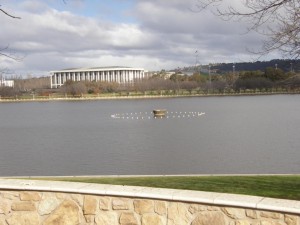
The Captain Cook Memorial Jet plays from this nozzle in Lake Burley Griffin between 2 and 4pm everyday (except when we’re in town!)
Once we’d had a good drive around, we parked at Old Parliament House and went in for a look round. There was a guided tour just starting, so we joined that, and spent a very interesting 45 minutes wandering around the building, going into the two chambers – the Senate and House of Representatives – and through the old Prime Minister’s offices, and finding out about how badly cramped it had been by the time they moved into the new building – it was originally designed with the expectation that it would need to house around 500 people, and by the time they moved out, there were 3000 people working there, with offices created out of old broom cupboards and toilets and all sorts of things! From there, we drove across to the new Parliament House, and went for a wander around the new and much bigger chambers, and took the lift up to the roof to take photos, and had a good look round. We had a wonderful overheard moment when a chap walked into the Senate chamber with his little girl, who can’t have been older than 7, and she gasped in a starstruck kind of way and said ‘Dad! This is the place we watch on TV!’

Looking out over the Old Parliament Building (now the Museum of Democracy) to the War Memorial from the roof of the new Parliament Building
We left there as it closed at 5, and drove out to the Exhibition Park In Canberra (EPIC!) where there’s a campsite – we’d missed the office, but it had a sign on the door which said ‘If we’re shut, choose a site and come back in the morning to pay us’, so we went and got ourselves settled in, made supper, called Rod and Barb to make plans to go and visit them in Melbourne, and then Skyped for a chat with Andy, Holls, David and Frazer. We were grateful for all our extra bedding that night, it was bloody cold! The next morning we went and paid for our camping, and then went into town to run errands – supermarket, petrol, coffee – and then drove out to Tidbinbilla, to the Canberra Deep Space Communications Complex. It’s one of three places in the world that monitor communications for NASA space missions – the others are in Madrid and the US – and it’s a working centre, but you can park outside and walk into the visitors’ centre, which has got lots of good displays on the history of space travel, the technology of space suits, what astronauts eat in space, a display of moon rocks, a model of the Mars Rover, information about current NASA missions – very interesting. We could have spent much longer there, watching video presentations, but we decided we’d better get going and make some headway towards Melbourne! So we set off and got in a few hours’ driving before we stopped at White Rock.
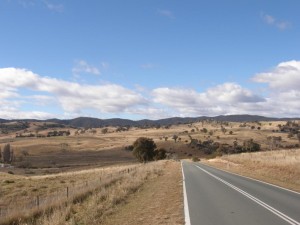
Just beyond the first ridge are the dishes of tracking station Canberra which handled the live feed of the first moon landing in 1969

“Tracking Station Canberra, come in Tracking Station Canberra…” – BEEP – (War of the Worlds anyone?)
While I’ve been writing this, we’ve driven into Victoria, and we’re now on the Princes Highway driving along the coast towards Melbourne. It’s about a 5 hour drive, so with a few stops we should be arriving at Rod and Barb’s just before dark. It’s very nice of them to have us to stay – we really got on well with them in the Whitsundays, so we’re looking forward to catching up, and getting some tips from them on what we should see while we’re in Melbourne!


